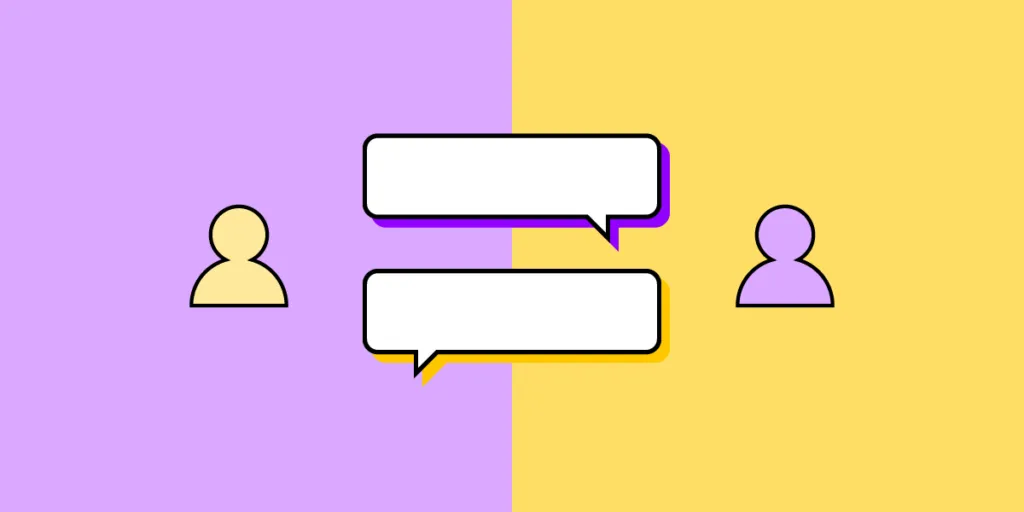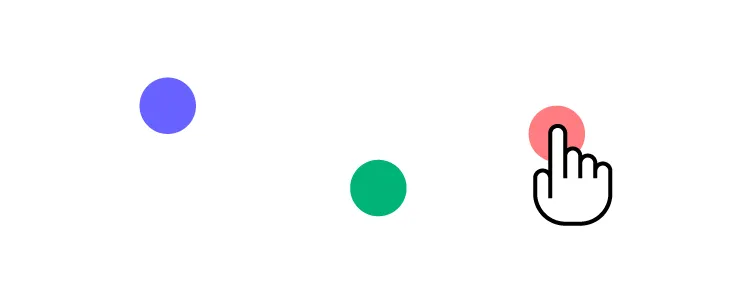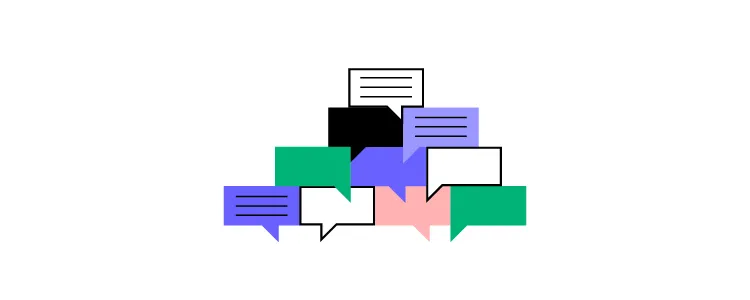Stakeholder Interview Questions – What to Ask About During Discovery?

Stakeholder interviews can be an anxious and overwhelming experience for first-timers wanting to impress. These interviews are crucial for UX design because they provide valuable details, context, and insights that guide projects–information designers can only get through relevant stakeholders and experts.
This article provides a seven-step template for planning and conducting stakeholder interviews, including how to prepare questions.
Get meaningful feedback from stakeholder interviews with high-quality interactive prototypes from UXPin. Try UXPin’s advanced design and prototyping features. Sign up for a free trial.
Internal vs. External Stakeholders
Internal stakeholders are people within an organization, including employees, management, execs, the board, and shareholders. These internal stakeholders are directly interested in the company’s decision-making and operations.
External stakeholders are indirectly interested in the organization, such as customers, suppliers, experts, creditors, and the community. These people don’t have decision-making power, but the company’s actions can affect them. For example, raising prices impacts customers, while discontinuing a product might affect suppliers.
This article will focus on internal stakeholders (and external experts) and how to interview them for design projects.
What is the Role of Stakeholders in Design Projects?
Stakeholders provide input on a design project’s goals, objectives, requirements, scope, budgets, and timelines. Stakeholders also offer feedback, support, and advice throughout the design process to ensure the project successfully meets its goals and objectives.
Understanding each interviewee’s role and interests can help improve communication and ensure the project meets their expectations.
What is the Purpose of a Stakeholder Interview?

Stakeholder interviews serve several purposes.
Understand business goals
Stakeholders have a high-level view of a project’s goals and objectives and how these relate to their department and the organization. Interviewing stakeholders before kick-off helps designers understand their strategic priorities and how these relate to the project.
Understand project constraints
Every project has constraints designers must work within–technical, budget, time, labor, etc. Stakeholders can help designers understand these limitations and how these might affect the project’s design and final release.
Understanding end-user needs
Stakeholders often initiate a design project because they’ve identified a user need or pain point. Talking to these stakeholders helps designers understand the problem, review existing user research, and discuss additional UX research they may need.
Stakeholder feedback sessions
Designers meet for regular feedback sessions with stakeholders throughout the design process. During these sessions, designers must explain concepts and ask stakeholders about feasibility and practicality. For example, the design team might have an idea and want to speak to a technical stakeholder to learn whether the product’s current tech stack can support it.
Stakeholder buy-in and support
Designers often have to get buy-in at various stages of the design process. These interviews include speaking to key stakeholders and getting support from decision-makers who can help advocate for design concepts and initiatives.
Mediating conflicting views
It’s not unusual for stakeholders to have conflicting views based on each department’s different strategic goals and priorities. These interviews can be tricky as designers must mediate interviews to find a win-win solution. For example, designers might present a concept that incorporates both ideas with some degree of compromise from both parties.
How do you Prepare and Conduct a Stakeholder Interview?

Step 1: Conduct a stakeholder analysis
A stakeholder analysis is a process of identifying the people who have a vested interest or power to influence a project. Designers can use their findings to list and segment stakeholders so that they can focus on key decision-makers and their business needs.
Further reading: What is Stakeholder Analysis and How Product Teams Should Do It?
Step 2: Research the stakeholder
The first step is understanding your stakeholder’s position, interests, and goals and how these relate to your project. This preparation will help tailor your questions and conversation to their needs.
The biggest mistake you can make is asking stakeholders irrelevant questions or being poorly prepared–especially for busy experts, managers, and execs.
Step 3: Set your interview goal(s)
What insights do you want to learn from the stakeholder? Exploring why you want to speak to a stakeholder is crucial for setting the interview’s goals.
Some interview goal examples include:
- What are the stakeholder’s business goals?
- What are the product’s technical limitations?
- What is the stakeholder’s definition of success for this project?
- Who are the major competitors?
- What are the project’s key performance metrics/indicators (KPIs)
Defining a goal for the interview will enable you to craft and ask the right questions.
Step 4: Prepare a list of questions
Prepare a list of questions that will help gain insights into the stakeholder’s needs and expectations. The best approach to interviewing stakeholders is to ask questions as if you know nothing about the topic. This style of question encourages stakeholders to explain and elaborate in greater detail.
Stakeholder interview questions are similar to user interviews. You want to ask open-ended questions to get unbiased answers. Identify points where you want stakeholders to elaborate or go into more detail based on your interview goals.
Adam Fard, founder of the UX agency Adam Fard recommends keeping the tone conversational. “Remember, the interview should be steered in a more conversational direction. Although preparing specific questions is important, avoid asking them in a way that makes it seem like you’re just checking off bullet points on a list.”
It’s also good to prioritize your questions and ask them in order of importance in case the interview runs out of time.
Step 5: Set an agenda
Create an agenda with the topics you want to cover and how much time to spend on each. Structuring your interview will help keep the conversation flowing and ensure you get through all your questions.
Stakeholder interviews typically last 30-60 minutes, so be realistic about the time it’ll take to cover each topic.
Step 6: Conducting the interview
If the stakeholder allows it, recording interviews is best for future reference and analysis. Recording interviews negates the need to take detailed notes, allowing you to focus 100% on the stakeholder’s answers. If you don’t get permission to record the interview, get a team member to take notes so you can focus on the conversation.
Start by introducing yourself, the project you’re working on, and the reason for the interview–the goal you set in step two.
Always start your questions by asking the stakeholder about their role in the organization and their interests in the project. You’ll also want to ask what their team/department is working on (i.e., their priorities), what metrics they’re tracking, and their goals for the quarter/year. This information will help you understand their reasons and motivations.
Sarah Gibbons from the NN Group recommends using open-ended probing follow-up questions when you want more detail or clarity, for example:
- Tell me more about that…?
- Can you expand on that…?
- Can you give me an example…?
- Can you tell me about the last time that you did…?
- How do you feel about that…?
Or, relating to specific ideas:
- Tell me why you felt that way.
- Tell me why you did that.
- Why is that important to you?
- Why does that stand out in your memory?
These questions are more important than the initial question because they’ll give you reasoning and insights into what the team has already tried, so you don’t waste time going down the same path.
Once you have gone through your questions, finish the interview by asking, “who else should we talk to?” This question is especially crucial if the stakeholder cannot provide a comprehensive answer or is unsure about specific details.
Step 7: Follow up
It’s good practice to follow up with an email thanking the stakeholder for their time and reminding them about any additional information or resources they would share.
Enhance Stakeholder Relationships and Increase Buy-in With UXPin
UXPin’s interactive prototypes allow stakeholders to experience design concepts like they would the final product. These high-quality prototypes offer several key benefits for stakeholder relations:
- Boost confidence in design teams
- Increase buy-in for ideas
- Better usability testing
- Identify and test more business opportunities
- Improve stakeholder feedback
- Enhance the final product user experience
- Minimize design handoff friction
- Reduce time-to-market
With UXPin’s Comments, stakeholders can leave feedback on specific features and assign comments to team members, even if they don’t have a UXPin account–perfect for collaboration with non-designers.
Enhance stakeholder collaboration and relationships with high-quality interactive prototypes from UXPin. Sign up for a free trial to explore UXPin.




